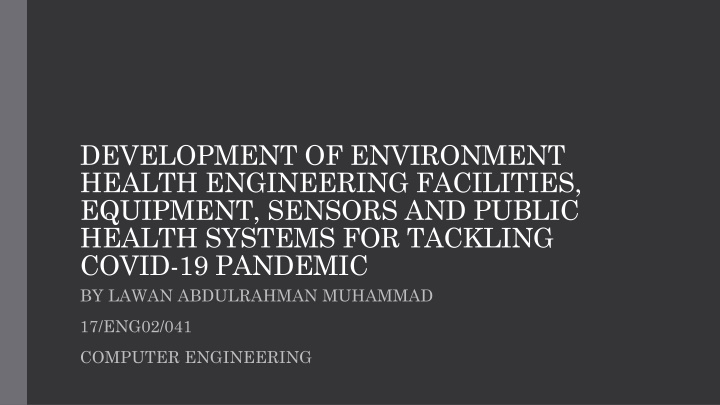Development of Environment Health Engineering Facilities for Tackling COVID-19 Pandemic
This article discusses the development of environment health engineering facilities, equipment, sensors, and public health systems to combat the COVID-19 pandemic. It covers topics related to environmental engineering, health engineering, and public health systems.
Uploaded on Feb 25, 2025 | 0 Views
Download Presentation

Please find below an Image/Link to download the presentation.
The content on the website is provided AS IS for your information and personal use only. It may not be sold, licensed, or shared on other websites without obtaining consent from the author.If you encounter any issues during the download, it is possible that the publisher has removed the file from their server.
You are allowed to download the files provided on this website for personal or commercial use, subject to the condition that they are used lawfully. All files are the property of their respective owners.
The content on the website is provided AS IS for your information and personal use only. It may not be sold, licensed, or shared on other websites without obtaining consent from the author.
E N D
Presentation Transcript
DEVELOPMENT OF ENVIRONMENT HEALTH ENGINEERING FACILITIES, EQUIPMENT, SENSORS AND PUBLIC HEALTH SYSTEMS FOR TACKLING COVID-19 PANDEMIC BY LAWAN ABDULRAHMAN MUHAMMAD 17/ENG02/041 COMPUTER ENGINEERING
CONTENTS ABSTRACT INTRODUCTION HISTORY OF CORONAVIRUS HISTORY OF CORONAVIRUS (SARS-Cov-2 ALSO KNOWN AS COVID-19) HOW TO KEEP YOUR SAFE OR PREVENT SPREAD OF COVID-19 WHAT IS ENVIRONMENT ENGINEERING WHAT IS HEALTH ENGINEERING PUBLIC HEALTH SYSTEMS WHAT ARE THE ROLES OF PUBLIC HEALTH SYSTEMS
CONTENTS ENVIRONMENT HEALTH AND PUBLIC HEALTH HOW TO IDENTIFY FACTORS AFFECTING COVID-19 TRANSMISSION ENVIRONMENTAL ENGINEERS AT DISCUSS HOW TO IDENTIFY FACTORS AFFECTING COVID-19 TRANSMISSION DEVELOPMENT OF ENVIRONMENT HEALTH ENGINEERING FACILITIES, EQUIPMENT, SENSORS AND PUBLIC HEALTH SYSTEMS FOR TACKLING COVID-19 PANDEMIC ACKNOWLEDGEMENT CONCLUSION REFERENCES
ABSTRACT In Environmental engineering is a professional engineering discipline that takes from broad scientific topics like chemistry, biology, ecology, geology, hydraulics, hydrology, microbiology, and mathematics to create solutions that will protect and also improve the health of living organisms and improve the quality of the environment. Environmental engineering is a sub-discipline of civil engineering , chemical engineering and and mechanical engineering. Environmental health is the branch of public health concerned with all aspects of the natural and built environment affecting human health. Environmental health is focused on the natural and built environments for the benefit of human health. The major subdisciplines of environmental health are: environmental science; environmental and occupational medicine, toxicology and epidemiology. Public health has been defined as "the science and art of preventing disease , prolonging life and improving quality of life through organized efforts and informed choices of society, organizations, public and private, communities and individuals Keywords: Environmental engineering, Environmental health, Public health systems
INTRODUCTION Well am going to talk about development of environment health engineering facilities, equipment, sensors and public health systems for tackling covid-19 pandemic and we talk about coronavirus and how to tackle by the application of computer engineering in medical health sector by creating facilities, equipment, sensors, and public systems etc. Environmental engineers devise solutions for waste water management, water and air pollution control, recycling, waste disposal, and public health. They design municipal water supply and industrial wastewater treatment systems, and design plans to prevent waterborne diseases and improve sanitation in urban, rural and recreational areas. Environmental engineers devise solutions for wastewater management, water and air pollution control, recycling, waste disposal, and public health. They design municipal water supply and industrial wastewater treatment systems, and design plans to prevent waterborne diseases and improve sanitation in urban, rural and recreational areas.
INTRODUCTION And we also have healthcare engineering in the category, Health Systems Engineering or Health Engineering (often known as "Health Care Systems Engineering (HCSE)") is an academic and a pragmatic discipline that approaches the health care industry, and other industries connected with health care delivery, as complex adaptive systems, and identifies and applies engineering design and analysis principles in such areas. Public health systems are commonly defined as all public, private, and voluntary entities that contribute to the delivery of essential public health services within a jurisdiction. The focus of a public health intervention is to prevent and mitigate diseases, injuries and other health conditions through surveillance of cases and the promotion of healthy behaviors, communities and environments. Many diseases are preventable through simple, nonmedical methods. For example, research has shown that the simple act of handwashing with soap can prevent the spread of many contagious diseases
HISTORY CORONAVIRUS (COVID-19) Coronaviruses are a group of related viruses that cause diseases in mammals and birds. In human, coronaviruses causes respiratory tract infections that can range from mild to lethal. Mild illnesses include some cases of the common cold, while more lethal varieties can cause SARS, MERS, COVID-19. symptoms in other species vary: in chickens, they cause an upper respiratory tract disease, while in cows and pigs they cause diarrhea. There are yet to be vaccines or antiviral drugs to prevent or treat human coronavirus infections. Coronaviruses were first discovered in the 1930s when an acute respiratory infection of domesticated chickens was shown to be caused by infectious bronchitis virus (IBV). In the 1940s, two more animals coronaviruses, mouse hepatitis virus (MHV) and transmissible gastroenteritis virus (TGEV), were isolated. Human coronaviruses were discovered in the 1960s. The earliest ones studied were from human patients with the common cold, which were later named human coronavirus 229E and human coronavirus OC43. other human coronaviruses have been identified, including SARS-CoV in 2003, HCoV NL63 in 2004, HKU1 in 2005, MERS-CoV in 2012, and SARS- Cov-2 in 2019.
HISTORY OF CORONAVIRUS (SARS-Cov-2 ALSO KNOWN AS COVID-19) Severe acute respiratory syndrome coronavirus 2 (SARS-Cov2) is the virus that causes coronavirus disease 2019 (COVID-19), a respiratory illness. It is colloquially known as the coronavirus, SARS-CoV-2 is a positive- sense single- stranded RNA virus. It is contagious in humans, and the world health organization (WHO) has designated the ongoing pandemic of COVID- 19 a public health of international concern. Because the strain was first discovered in wuhan, china, it is sometimes referred to as the wuhan virus . Since the WHO discourages the use of name based on locations and to avoid confusion with the disease SARS, or COVID-19 in public communications. It can invade your body when you breathe it in (after someone coughs nearby) or you touch a contaminated surface and then your face. It first infects the cells lining your throat, airways and lungs and turns them into coronavirus factories that spew out huge numbers of new viruses that go on to infect yet more cells. But mostly the common symptoms are cough and fever.
HISTORY OF CORONAVIRUS (SARS-Cov-2 ALSO KNOWN AS COVID-19) Illustration of the morphology of coronavirus; the club-shaped viral spike peplomers, colored red, create the look of a corona surrounding the virion when observed with an election microscope.
HOW TO KEEP YOUR SAFE OR PREVENT SPREAD OF COVID-19 Stay at homes no unnecessary journeys or social contact Only leave home for essential shopping, medical needs and exercise once a day You can travel to and from work if absolutely necessary Avoid public gatherings Don t visit other people s houses or socialize outside your home If unwell isolate yourself and your family Keep in touch with one another with devices Wash hands for about 20 seconds with soap and hot water or use a sanitizer gel Use a tissue for coughs and sneezes and if you don t have tissue use your sleeve Avoid touching your eyes, nose, and mouth unwashed
WHAT IS ENVIRONMENT ENGINEERING Environmental engineering is a professional engineering discipline that takes from broad scientific topics like chemistry, biology, ecology, geology, hydraulics, hydrology, microbiology, and mathematics to create solutions that will protect and also improve the health of living organisms and improve the quality of the environment. Environmental engineering is a sub-discipline of civil engineering , chemical engineering and mechanical engineering. Environmental engineering is the application of scientific and engineering principles to improve and maintain the environment to: protect human health, protect nature's beneficial ecosystems, and improve environmental-related enhancement of the quality of human life.
WHAT IS ENVIRONMENT ENGINEERING Ancient civilizations Environmental engineering is a name for work that has been done since early civilizations, as people learned to modify and control the environmental conditions to meet needs. As people recognized that their health was related to the quality of their environment, they built systems to improve it. The ancient Indus Valley Civilization (3300 B.C.E. to 1300 B.C.E.) had advanced control over their water resources. The public work structures found at various sites in the area include wells, public baths, water storage tanks, a drinking water system, and a city-wide sewage collection system. They also had an early canal irrigation system enabling large-scale agriculture. Modern era Very little change was seen from the fall of Rome until the 19th century, where improvements saw increasing efforts focused on public health. Modern environmental engineering began in London in the mid-19th century when Joseph Bazalgette designed the first major sewerage system following the Great Stink. The city's sewer system conveyed raw sewage to the River Thames, which also supplied the majority of the city's drinking water, leading to an outbreak of cholera. The introduction of drinking water treatment and sewage treatment in industrialized countries reduced waterborne diseases from leading causes of death to rarities
WHAT IS HEALTH ENGINEERING Health Systems Engineering or Health Engineering (often known as "Health Care Systems Engineering (HCSE)") is an academic and a pragmatic discipline that approaches the health care industry, and other industries connected with health care delivery, as complex adaptive systems, and identifies and applies engineering design and analysis principles in such areas. This can overlap with biomedical engineering which focuses on design and development of various medical products; industrial engineering and operations management which involve improving organizational operations; and various health care practice fields like medicine, pharmacy, dentistry, nursing, etc. Other fields participating in this interdisciplinary area include public health, information technology, management studies, and regulatory law. People whose work implicates this field in some capacity can include members of all the above-noted fields, many of which have sub-fields targeted toward health care matters even if health or health care is not a principal focus of the overall field (e.g. management, law). Areas of biomedical engineering (BME) in this area often include clinical engineering (sometimes also called "hospital engineering") as well as those BMEs developing medical devices and pharmaceutical drugs. The industrial engineering (IE) principles employed tend to include optimization, decision analysis, human factors engineering, quality engineering, and value engineering.
PUBLIC HEALTH SYSTEMS Public health systems are commonly defined as all public, private, and voluntary entities that contribute to the delivery off essential public health services with in a jurisdiction. The National Public Health Performance Standards Program (NPHPSP) developed by the CDC (which we will use at the 2006 Health Forum) focuses on assessing and improving the overall public health system. This assures that the contributions of all entities are recognized in assessing the provision of the 10 Essential Public Health Services. It is important to note that this program is not designed to assess the performance of any one agency within the public health system, but the system s performance with the goal of quality improvement.
WHAT ARE THE ROLES OF PUBLIC HEALTH SYSTEMS Some of the organizations and sectors that are involved in the public health system include: Public health agencies, such as the state or local health department, which serve as the governmental entity for public health and play a major role in creating and ensuring the existence of a strong public health system. Health care providers, such as hospitals, physicians, community health centers, mental health organizations, laboratories, and nursing homes, which provide preventive, curative, and rehabilitative care. Public safety organizations, such as police, fire and emergency medical services. Their work is often focused on preventing and coping with injury and other emergency health-related situations. Recreational and art-related organizations, that contribute to the physical and mental well-being of the community and those who live, work, and play in it.
WHAT ARE THE ROLES OF PUBLIC HEALTH SYSTEMS Human service and charity organizations such as food banks, public assistance agencies, and transportation providers, which assist people to access healthcare and receive other health enhancing services. Educational and youth development organizations such as schools, faith institutions, youth centers, and other groups that assist with informing, educating, and preparing children to make informed decisions and act responsively regarding health and other life choices and to be productive contributors to society. Economic and philanthropic organizations such as employers, community development organizations, zoning boards, and community and business foundations that provide resources necessary for individuals and organizations to survive and thrive in the community. Environmental agencies or organization which contribute to, enforce laws related to, or advocate for a healthy environment.
ENVIRONMENT HEALTH AND PUBLIC HEALTH Environmental health professionals may be known as environmental health officers, public health inspectors, environmental health specialists, environmental health practitioners, or sanitarians. Researchers and policy-makers also play important roles in how environmental health is practiced in the field. In many European countries, physicians and veterinarians are involved in environmental health. In the United Kingdom, practitioners must have a graduate degree in environmental health and be certified and registered with the Chartered Institute of Environmental Health or the Royal Environmental Health Institute of Scotland. In Canada, practitioners in environmental health are required to obtain an approved bachelor's degree in environmental health along with the national professional certificate, the Certificate in Public Health Inspection (Canada) CPHI(C).Many states in the United States also require that individuals have a bachelor's degree and professional licenses in order to practice environmental health. Environmental health addresses all human-health-related aspects of the natural environment and the built environment. Environmental health concerns include: Air quality, including both ambient outdoor air and indoor air quality, which also comprises concerns about environmental tobacco smoke, Biosafety, Disaster preparedness and response, Climate change and its effects on health.
ENVIRONMENT HEALTH AND PUBLIC HEALTH Public health aims to improve the quality of life through prevention and treatment of disease, including mental health. This is done through the surveillance of cases and health indicators, and through the promotion of healthy behaviors. Common public health initiatives include promotion of handwashing and breastfeeding, delivery of vaccinations, suicide prevention, and distribution of condoms to control the spread of sexually transmitted diseases. Modern public health practice requires multidisciplinary teams of public health workers and professionals. Teams might include epidemiologists, biostatisticians, medical assistants, public health nurses, midwives, medical microbiologists, economists, sociologists, geneticists, data managers, and physicians. Depending on the need, environmental health officers or public health inspectors, bioethicists, and even veterinarians, gender experts, or sexual and reproductive health specialists might be called on.
HOW TO IDENTIFY FACTORS AFFECTING COVID-19 TRANSMISSION Scientists and medical experts don't have a good understanding of what virus characteristics and environmental factors control virus persistence in the environment -- for example, in aerosols and droplets, on surfaces including skin and in water including seawater, according to Boehm and Wigginton. "When a new virus emerges and poses a risk to human health, we don't have a good way of predicting how it will behave in the environment," Boehm said. Part of the problem is historically there has been limited funding for this sort of work. The National Institutes of Health historically hasn't funded work on pathogens in the environment, and funding at the National Science Foundation for this work is limited. Also, coronaviruses and most of the emerging viruses that have caught the world's attention over the last decade are enveloped viruses that are wrapped in an outer layer of fatty lipid molecules that they've stolen from their hosts. Proteins on the surface of the envelopes can help these viruses evade the immune systems of the organisms they are infecting. "There has been much more work on the fate of non-enveloped or naked viruses because most intestinal pathogens in excrement are nonenveloped viruses -- like norovirus and rotavirus," said Wigginton.
ENVIRONMENTAL ENGINEERS AT DISCUSS HOW TO IDENTIFY FACTORS AFFECTING COVID-19 TRANSMISSION According to ROB JORDAN Stanford Woods Institute for the Environment Much remains unknown about how SARS-CoV-2, the virus that causes COVID-19, spreads through the environment. A major reason for this is that the behaviors and traits of viruses are highly variable some spread more easily through water, others through air; some are wrapped in layers of fatty molecules that help them avoid their host s immune system, while others are naked. This makes it urgent for environmental engineers and scientists to collaborate on pinpointing viral and environmental characteristics that affect transmission via surfaces, the air and fecal matter, according to Alexandria Boehm, a Stanford professor of civil and environmental engineering, and Krista Wigginton, the Shimizu Visiting Professor in Stanford s department of civil and environmental engineering and an associate professor at the University of Michigan.
ENVIRONMENTAL ENGINEERS AT DISCUSS HOW TO IDENTIFY FACTORS AFFECTING COVID-19 TRANSMISSION This transmission electron microscope image shows SARS-CoV-2, the virus that causes COVID-19. (Image credit: NIAID-RML / Flickr)
ENVIRONMENTAL ENGINEERS AT DISCUSS HOW TO IDENTIFY FACTORS AFFECTING COVID-19 TRANSMISSION As environmental engineers, what do you think are some of the biggest gaps in our understanding of and ability to control viruses such as SARS-CoV-2? Boehm: We don t have a good understanding of what virus characteristics and environmental factors control virus persistence in the environment for example, in aerosols and droplets, on surfaces including skin and in water including seawater. When a new virus emerges and poses a risk to human health, we don t have a good way of predicting how it will behave in the environment. Part of the problem is historically there has been limited funding for this sort of work. The National Institutes of Health historically hasn t funded work on pathogens in the environment, and funding at the National Science Foundation for this work is limited. Also, coronaviruses and most of the emerging viruses that have caught the world s attention over the last decade are enveloped viruses that are wrapped in an outer layer of fatty lipid molecules that they ve stolen from their hosts. Proteins on the surface of the envelopes can help these viruses evade the immune systems of the organisms they are infecting. There has been much more work on the fate of non-enveloped or naked viruses because most intestinal pathogens in excrement are nonenveloped viruses like norovirus and rotavirus.
ENVIRONMENTAL ENGINEERS AT DISCUSS HOW TO IDENTIFY FACTORS AFFECTING COVID-19 TRANSMISSION What are some promising or critical research areas for informing our response to viral outbreaks? Boehm: If we could develop models to predict the environmental survival of novel viruses, that would be a huge step forward. To do so, we need to understand mechanistically how different characteristics of the virus such as size and composition affect how environmental factors such as temperature and disinfectants control their survival. There are also opportunities to better understand how human behavior plays into viral transmission. For example, knowledge about how efficiently a virus can move from a surface to a hand should be informed by the kinds of surfaces that people actually touch, and can, in turn, inform health behavior interventions that will actually reduce exposure.
ENVIRONMENTAL ENGINEERS AT DISCUSS HOW TO IDENTIFY FACTORS AFFECTING COVID-19 TRANSMISSION Are viruses such as SARS-CoV-2 a threat to our water sources? Boehm: We usually only worry about viruses in water if they are excreted by humans in their feces and urine. Most enveloped viruses aren t excreted in feces or urine, so they aren t usually on our minds when it comes to our water sources. There is increasing evidence that the SARS-CoV-2 viruses, or at least their genomes, are excreted in feces. If infective viruses are excreted, then fecal exposure could be a route of transmission. It s unlikely this could be a major transmission route, but a person could potentially be exposed by interacting with water contaminated with untreated fecal matter. Wigginton: We ve designed our drinking water treatment systems with lots of treatment barriers to remove the most prevalent viruses and the most difficult-to-remove viruses. Research on viruses similar to the SARS-CoV-2 virus suggests they are susceptible to these treatments. In terms of virus concentration and persistence, this isn t a worst-case scenario.
ENVIRONMENTAL ENGINEERS AT DISCUSS HOW TO IDENTIFY FACTORS AFFECTING COVID-19 TRANSMISSION How can experts from different disciplines collaborate research efforts to maximize their value to public health? Wigginton: Environmental engineers and scientists are mostly looking at pathogens outside of the host. They are detecting pathogens in environmental samples, understanding their environmental fate or designing approaches, such as water disinfection, to remove them from the environment. Meanwhile, virologists are studying what happens within the host cells, and public health scientists are trying to understand people s exposure to the virus and how it circulates through communities. Research questions and techniques are sometimes quite similar across these fields. So, by working together we can move methods forward faster. Working across disciplines can lead to discoveries and strategies that wouldn t be possible independently.
DEVELOPMENT OF ENVIRONMENT HEALTH ENGINEERING FACILITIES, EQUIPMENT, SENSORS AND PUBLIC HEALTH SYSTEMS FOR TACKLING COVID-19 PANDEMIC Well after the definition of some terms and proving's of some environmental engineers and scientists. As for the equipment Laboratory equipment is an important part of your laboratory safety program. This equipment is considered an "engineering control". Engineering controls eliminate or reduce exposure to a biological, chemical or physical hazard through the use or substitution of engineered machinery or equipment. Examples include self-capping syringe needles, ventilation systems such as a fume hood or biosafety cabinet, sound- dampening materials to reduce noise levels, safety interlocks, and radiation shielding. The first and best strategy is to control the hazard at its source. Engineering controls do this, unlike other controls that generally focus on the employee exposed to the hazard. The basic concept behind engineering controls is that, to the extent feasible, the work environment and the job itself should be designed to eliminate hazards or reduce exposure to hazards.
DEVELOPMENT OF ENVIRONMENT HEALTH ENGINEERING FACILITIES, EQUIPMENT, SENSORS AND PUBLIC HEALTH SYSTEMS FOR TACKLING COVID-19 PANDEMIC Engineering controls can be simple in some cases. They are based on the following principles: If feasible, design the facility, equipment, or process to remove the hazard or substitute something that is not hazardous. If removal is not feasible, enclose the hazard to prevent exposure in normal operations. Where complete enclosure is not feasible, establish barriers or local ventilation to reduce exposure to the hazard in normal operations.
DEVELOPMENT OF ENVIRONMENT HEALTH ENGINEERING FACILITIES, EQUIPMENT, SENSORS AND PUBLIC HEALTH SYSTEMS FOR TACKLING COVID-19 PANDEMIC When substitution of hazardous chemicals or processes is simply not possible, additional measures to control employee exposure need to be taken. While personal protective equipment (PPE) such as respirators can help protect an individual from a hazardous material, engineering controls protect all workers by reducing or eliminating the hazard. For example, someone who is spray-painting can wear a respirator to avoid inhaling toxic fumes, but nearby workers without any respiratory protection will be exposed. Through the use of proper local exhaust ventilation everyone can be protected. This does not mean that engineering and other types of controls (including PPE) are mutually exclusive. Laboratories may need to use multiple types of controls to prevent overexposures. Research laboratories may use equipment such as bunsen burners, rotary evaporators, autoclaves, hot plates and centrifuges that can be hazardous. Never use any equipment unless you have been trained on the proper use of the equipement.
DEVELOPMENT OF ENVIRONMENT HEALTH ENGINEERING FACILITIES, EQUIPMENT, SENSORS AND PUBLIC HEALTH SYSTEMS FOR TACKLING COVID-19 PANDEMIC Ventilator capacity for existing medical gas systems A tool, provided by Kaiser Permanente National Facilities Services, provides ventilator capacity based on piping sizes to assist in determining how many ventilators can be served by an existing medical gas system in a given patient care area. Sizing of medical gas systems for alternate care sites A tool, provides guidance on the sizing of medical gas systems for COVID-19 emergency units. Enforcement Policy for Personal Protective Equipment (PPE) During COVID-19: Immediately in Effect Guidance Enforcement Policy for Face Masks and Respirators During the Coronavirus Disease (COVID-19) Public Health Emergency (Revised) Enforcement Policy for Gowns, Other Apparel, and Gloves During the Coronavirus Disease (COVID-19) Public Health Emergency
DEVELOPMENT OF ENVIRONMENT HEALTH ENGINEERING FACILITIES, EQUIPMENT, SENSORS AND PUBLIC HEALTH SYSTEMS FOR TACKLING COVID-19 PANDEMIC The association recommends that health care organizations perform surgeries and other procedures on COVID-19 positive patients following the same guidelines for active TB patients. ASHE has issued recommendations for health care organizations to develop emergency and or fire response policies and procedures that will help limit exposure for those responding to emergencies in these isolated spaces. Frequently Asked Questions about COVID-19 questions and answers related to negative pressure patient rooms, construction, life safety concerns and disinfection issues. Converting alternate care sites to patient space options, Resources for increasing space capacity with alternate care sites such as hotels. Airborne Contaminant Removal table, Air changes/hour (ACH) and time required for airborne-contaminant removal by efficiency.
ACKNOWLEDGEMENT I appreciate all the researchers and copious professionals that have contributed to this work.
CONCLUSION Well as you can see after this my research that environment health engineering play a major role in this of COVID-19 and it try to make the surrounding good enough for COVID-19 patients isolated in the isolated centre and uninfected patients staying in their homes. Thank you
REFERENCES Giaimo C (1 April 2020) . Retrieved 6 April 2020 GorbalenyaAE, Baker SC, Baric RS, de Groot RJ, drosten C, GulyaevaAA, et al . ( 3 march 2020) ASHE (1 March 2020). Krista R. Wigginton et al. Environmental Engineers and Scientists Have Important Roles to Play in Stemming Outbreaks and Pandemics Caused by Enveloped Viruses, Environmental Science & Technology (2020). DOI: 10.1021/acs.est.0c01476 Wikipedia Google Chrome























